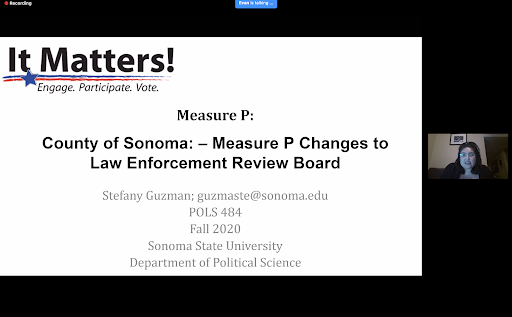SSU Students Tackle Ballot Measures
Sonoma State Political Science students took on the daunting task of breaking down the current California Ballot Measures in preparation for the upcoming election. Understanding propositions can be overwhelming to voters of all ages, Professor Dr. David McCuan’s POLS 484 class partnered with the Center for Community Engagement and the League of Women Voters to bring the “It Matters: California Ballot Measures Watch November 2020” event. This event focused on providing nonpartisan information on what each California proposition means, who is endorsing it, and what the outcomes of the propositions would be if they are passed.
The event kicked off with an overview and history about the Initiative process, presented by Nour Salameh and Gabriel Guptil. Guptil explained that most proposed initiatives never make it to the ballot. He said that this is common because “initiatives can be as wild as their author wants them to be.” Guptil used this as an example to emphasize the importance of truly understanding the propositions so you can make an informed decision.
Following this introduction, the students presented each measure one by one to a virtual audience of 250 students, staff, faculty, and community members. I felt that these students did an incredible job of breaking down the propositions and offering additional voter resources. As a student myself, I can only imagine the nerves they were feeling and I commend these students on how professional and well researched their presentations were.
This will be the first time I am able to vote in a major presidential election and this event opened my eyes to how truly complicated understanding the ballot is. It is now clear to me that simply reading the proposition description on the ballot is not sufficient enough to make a decision. I was surprised to find out that several propositions were worded in such a way that gave me the impression that it meant the complete opposite of the actual impact. I also appreciated how the students offered a breakdown of the major supporters and opposers of each measure. This helped me make my decision on how to vote when I was having a hard time understanding the proposition.
After the presentation, Salameh and Guptil moderated a Q&A session where viewers had the opportunity to ask clarifying questions. This was also quite helpful, as I had several of the same questions in mind that were being asked of the presenters. The students were well prepared to answer these questions and provide further information, showing just how much time and effort they put into their research.
This event was extremely beneficial, and without it I would have felt completely unprepared to vote. I now feel confident enough in my understanding of the propositions that I can make informed decisions when filling out the ballot.
The video of the event will be available on our YouTube channel.

Author: Stephanie Farris







